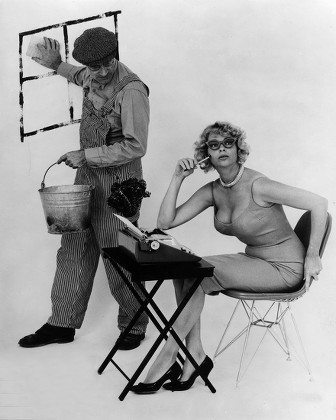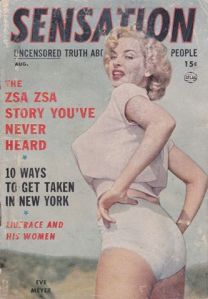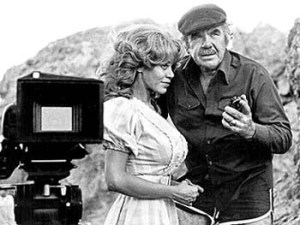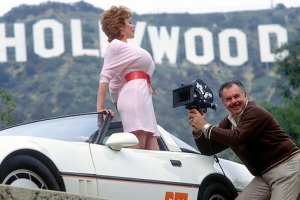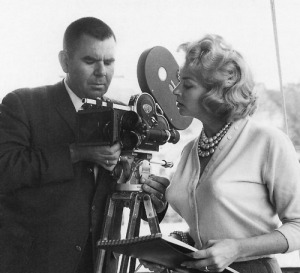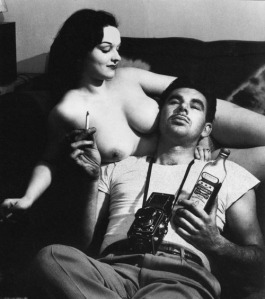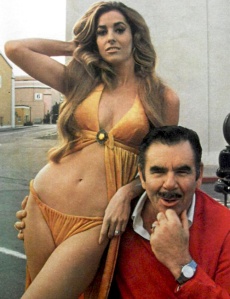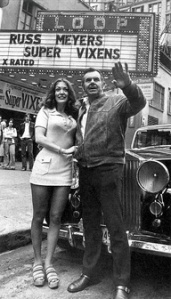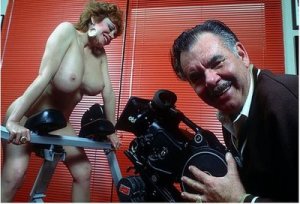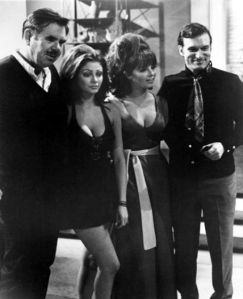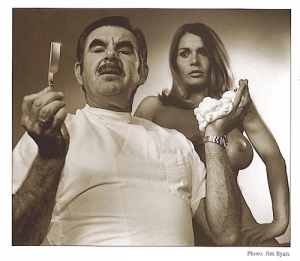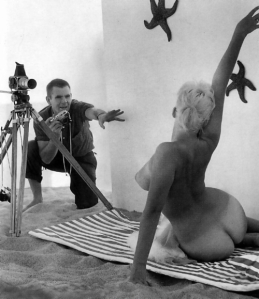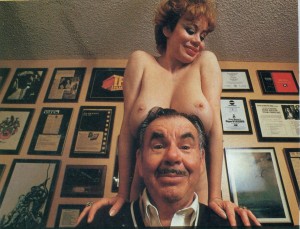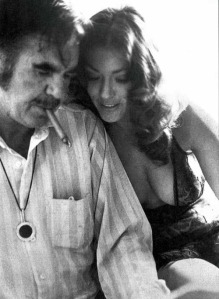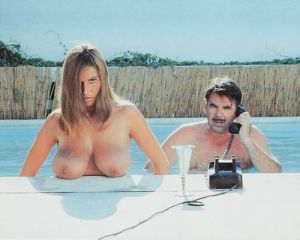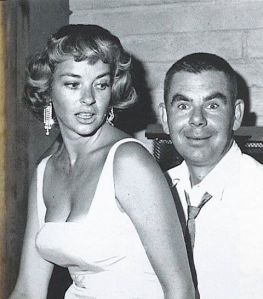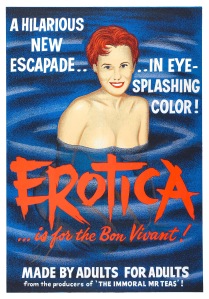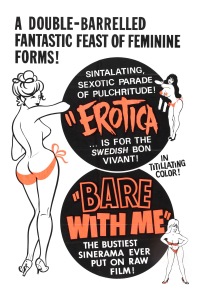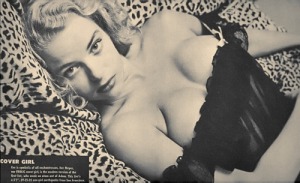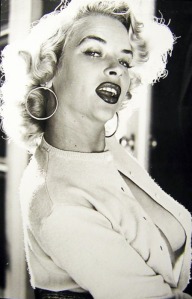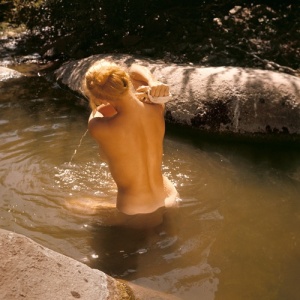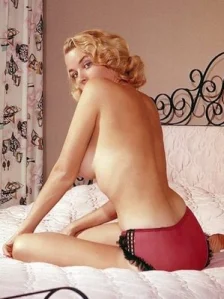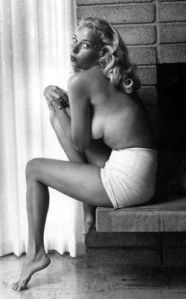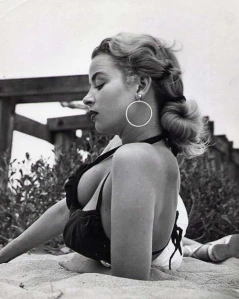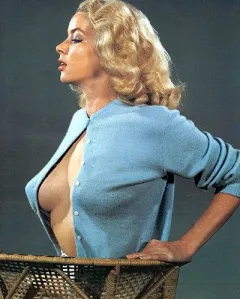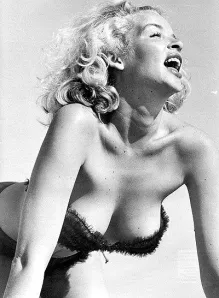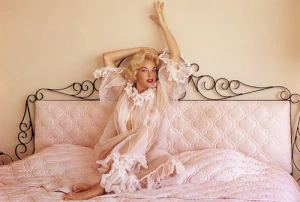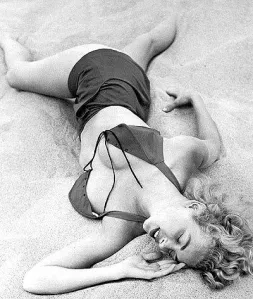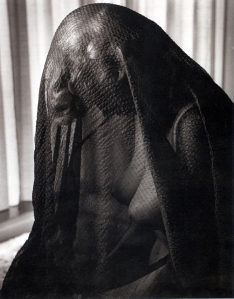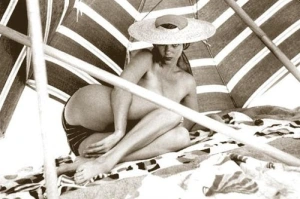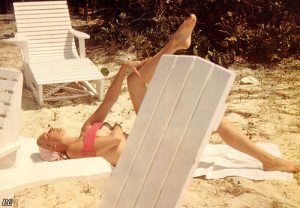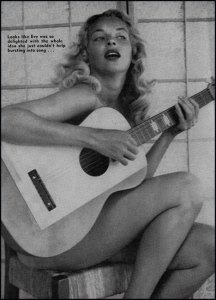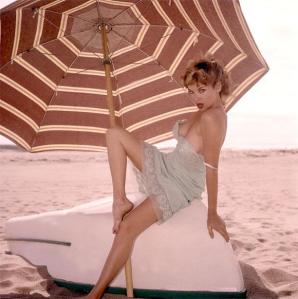Tags: Eve Meyer, Glamour photography, Globe Photos, Photography, Pin up, Pin Up photography, Russ Meyer
Tag Archives: Eve Meyer
MEYER MONTH – ‘Eve and The Handyman’ (1961) by Patrick Crain
13 MarRuss Meyer had to take incremental steps to get to become the storied and respected filmmaker that he eventually did. His first step was being a gifted photographer who was as adept at his skill as mortars and debris rained down around him in the heat of battle as he was while studying the contours of his models’ bodies as they were lying at the base of an oak tree while bathed in dappled sunlight. His second step was punching through the wall of morality and releasing The Immoral Mr. Teas, his groundbreaking film that introduced actual nudity in a motion picture to those who would pay for the privilege to see it.
I would bet that Meyer’s most important decision in the evolution of his success was hooking up with and marrying the former Eve Turner in 1952. No doubt that Meyer had talent to burn and that his personality caused him to be a little shrewd but Eve took his game to a whole other level. At once both his business partner and muse, Eve Meyer pumped life into his output in which she was the subject by being both impossibly built and having a uniquely strong relationship with the camera. In terms of what they did for each other and each other’s work, you’d probably have to look to Jess Franco and Lina Romay for something comparable.
So it’s something of a shame that, as far as his motion pictures went, Eve Meyer was only ever in front of the camera in Eve and the Handyman, Russ’s follow-up to the previous year’s Teas. But her presence in it is both sly and smart; Eve Meyer is the primary woman on display in this film and it ends up being ten times as effective as Teas without having to resort to any nudity on her behalf.
Like Teas before it, Eve and the Handyman is little more than a sketch-pad for Meyer’s visual ideas and micro-budgeted creativity. A jack-of-all-trades handyman (Anthony-James Ryan) is stalked by a mysterious, trench-coated blonde whose constant, double entendre-stacked voice-over narration positions the film as a bawdy, Dragnet-style procedural in which every move of the handyman is noted and remarked upon by his voyeuristic pursuer. Gone is the gimmick in which naked girls pop up to awkwardly pose in the daydreams and hallucinations of our protagonist and replaced by the laser-focus of our bumbling hero as he completes his day-to-day tasks, never minding the many buxom women he encounters along the way (mostly all played by Eve Meyer in various get-ups).
Where Teas reflected women contented to be placed like statues and given little to do, Eve wants women to be the driver of the engine. Teas wants to be a moving centerfold and Eve wants to be the whole damn magazine. The jokes are livelier, the mood is more jovial, and, more importantly, Eve Meyer flips the script by giving the audience the first taste of what would be a Russ staple; the woman is on top and the man is the dope. Sexually oblivious, Bill Ryan’s Handyman gets saddled with Eve Meyer almost exclusively because her mission is to, ostensibly, wise him up. So she becomes everywoman in his path while remaining the detective that wants to sell him toilet supplies in the end.
Eve Meyer’s presence in this film couldn’t help but inform Meyer as to what exactly he wanted in the future. For Eve Meyer is the first “Russ Meyer Woman.” Eve Meyer showed Russ Meyer how to present a woman who looked like she wanted to be wanted. More importantly, she wanted the audience to know she knew they knew that she wanted to be wanted. Untangle all that and you’re are the heart of what makes Russ Meyer’s films stand so far apart from other films of their ilk that the massive delta between them renders it unfair to mention them in the same breath. Show me a Russ Meyer film that’s blessed with a narrative structure and I’ll show you a heroine that sprung forth from Eve Meyer’s roots which are so firmly planted in this film.
Once past the nudie cuties, the cinema of Russ Meyer is as equally hilarious and exhilarating as it is titillating. And even if the nudie cuties are tame pieces of antiquity, they aren’t bereft of a good laugh or two. The jokes in Eve take a while to unfold and your mileage with them may vary; they might or might not be worth it, depending on your perspective. But this film is the first to have this specific blend of broad, sight-gag humor and sex which was mostly missing from Teas, a film that feels like it can barely breathe lest it get caught doing what it wants to be doing. Additionally, in employing a panoply of visual ideas representative of intercourse and orgasm (the constant churning of oil wells, the coupling of trains, etc.), Meyer gives the thrust of the train into the tunnel at the end of Hitchcock’s North By Northwest, itself released a scant one year earlier, nowhere to hide.
As stated before, there’s just not a lot of there there in the subgenre of the nudie cuties. They are what they are and the trick is to try and enjoy them with a sense of historical context because there just aren’t many of them that are going to stop the conversation at a dinner party and become the thing everyone will have to have seen before the next get-together. Depending on the director and the talent involved, they mostly all run the gamut between “unwatchable” and “pleasant enough”. With Eve and the Handyman, Russ and Eve Meyer joined forces to give the audience something a little more more memorable; electric burlesque compliments of Eve’s strong, palpable sexuality reminiscent of one of Howard Hawks’s joyously randy heroines and Meyer’s clean compositions, edited together like a breathless Gatling gun shooting off eye candy.
“The biggest catch in life, my friends, is a happy ending,” so says our heroine in the final line of the film. As much as that phrase meant something even in the creaky days of 1961, the film earns its right to use it as Eve and the Handyman, while not the best or bawdiest of Russ Meyer’s output, is truly his first effective mix of the sex and the sublime.
(C) Copyright 2021, Patrick Crain
Patrick Crain is a freelance writer and film programmer for the Oklahoma Film Society. He spends his days in semi-retirement by pacing around his home in Oklahoma City, watching movies, writing about them, and then pouring wine for both he and his wife at around 4:30CST. His scribblings about the motion pictures can be found at www.apollotwin.com. He can be found on Instagram here and on Twitter here. He is also on Letterboxd.
MEYER MONTH – ‘Erotica’ (1961)
15 MarThanks to the Russ Meyer Trust another one of the infamous sexploitation directors early films has finally seen the light of day after being out of circulation since its original theatrical release. The 1961 picture Erotica sits alongside a few of Meyer’s other early films in the Vintage Bodies Set which came out towards the end of last year. Shot after Meyer’s second feature Eve and the Handyman, Erotica consists of six small nudie cutie segments, another of Meyer’s films that plays out as a cinematic pin-up photography pictorial.
Meyer and his producer Pete DeCenzie fell out making Eve and the Handyman when he bailed out on the picture just before production had started. However, DeCenzie returned for Erotica, and later again on its follow-up Wild Gals of the Naked West, which was shot on a four grand budget. Also returning on the production was editor Charles G. Schelling who had helped Russ shoot French Peep Show (and would later go on to become sound recordist on the movies made during Meyer’s gothic period) and then-wife Eve with the role of financial co-ordination (something she ended up doing a lot of during her husbands career). Long-time friend and general all-rounder Anthony James Ryan also briefly cameos in the last vignette as the Handyman, his lead role in the directors previous picture, alongside another gentleman dressed in Mr. Teas’ lurid orange jumpsuit (never one to miss out on self promotion, Meyer had two one-sheets for both The Immoral Mr. Teas and Eve and the Handyman on prominent display at one point). This was a, as the films narration points out, ‘film made by adults for adults… It is truly Erotica!’.
In reality it is what it is, which for me is sadly one of the weaker entries in Meyer’s filmography and is, at times, really rather boring. Whilst it has two Meyer film staples, pretty topless women and bizarre indifferent narration, you can’t help but feel that other similar pictures like Europe In The Raw and Eve and the Handyman did it better and got away with a little more charm. The are some cute moments; the opening in particular is quite sweet, showing a very basic but behind the scenes look none the less at the process a film goes through with symbolic images to represent each part (someone cigarette smoking is the actor, a huge money bag the producer, disembodied hands cutting film being the editor, director chair for the director etc). Segment two ‘Beauties, Bubbles and H20’, an ode to the traditions and history of bathing (aka a trio of topless beauties washing themselves with very bubbly soap) also has some nice cinematography and photographic set ups, one can imagine that if the director had actually shot stills for this segment alone, they would have probably been quite stunning. The shots of one girl having a bubble bath in a kiddies blow up pool are particular favourites. This second vignette also featured popular model Althea Currier who already had an ucredited role in The Immoral Mr. Teas and would go on to appear in Heavenly Bodies and Lorna.
The rest of the picture feels very much the same with so much narration it makes you lose interest in anything the film has to offer (there’s even a soundtrack reel gag in one of the segments where off-screen voices argue that the narrator is reading the wrong ‘informative’ script, how very meta). Segment one, ‘Naked Innocence’, is essentially a re-tread of Meyer’s 1959 short This Is My Body starring Diane Webber, only This Is My Body is a lot better. Middle pieces ‘Nudists on the High Seas’ and ‘The Nymphs’ suffer from far too much narration and not enough going on visually to really make an impact whilst the last chapter, ‘The Bikini Busters’, is a bloated, unrealised comedic take on the history of the bikini; ‘and so it went, down through the years with more and more clothes being added, until the women got so much to looking like the men that the men stopped looking’.
The only other highlight in the feature is the short segment ‘The Bare and The Bear’ in which Meyer shoots an impressively endowed woman rolling around on a Malibu beach wearing only a bear skin to accompany narration that informs how durable and soft bear fur really is. This lucky lady was Sherri Knight, a model with a fifty-five inch bust that Meyer had shot for skin magazines before in the past. According to Jimmy McDonough’s biography, producer DeCenzie saw pictures of Knight and insisted that Meyer include her in the film. They shot for one day, wrapped and Meyer never saw her again. Not that it matters. Once you see her wearing the fur stole, you’ll never forget her.
Todd Rosken’s ‘Up The Valley and Beyond’ (2012)
6 MarThere’s a beautiful little film that’s spent the last year doing the festival rounds and if you’re a Russ Meyer or sexploitation film fan, it’s well worth seeking out. In fact, it’s well worth seeking out if you’re a film fan in general as this cinematic gem is well shot, well acted, well written and utterly full of charm. Up The Valley and Beyond is a short film, based on the book Russ Meyer, The Life and Films by David K. Frasier (itself one of the best books about the director), dramatically exploring the early stages of the marriage between the legendary filmmaker Russ Meyer and his model wife Eve Turner. Beginning with a great montage of black and white World War II footage highlighting where Meyer had come from (a great minute of editing in which editor Nickolas Perry really creates a sense of how the War was seen by the cameramen who filmed it), the film then bursts into gloriously bright 1950s pop colours and prints and shows how Meyer and Turner first met when he was looking for the ‘right built’ woman, eventually becoming a couple. Director Todd Rosken has struck casting gold with his two leads, Jim Parrack (True Blood, Sal, Battle Los Angeles) and Sarah Jones (Alcatraz, Big Love, Sons of Anarchy) who both pull off the real-life big characters. Parrack in particular is delightful as a younger Meyer, nailing the mannerisms and enthusiasm of the man himself and is a worthy candidate for the lead role in any future Meyer biopic. Equally good is Jones in the role of Eve, a tough woman to imitate and who Jones doesn’t quite nail completely in looks but certainly manages to bring across in fiery character.
The film has played at many major film festivals over the last year including the BFI London Film Festival, New York Film Festival, Seattle International Film Festival and the Palm Springs International Shortfest. What makes it stand out is the way in which Rosken and his crew have interpreted Meyer’s sense of style and substance, creating a playful fifteen minute dramatic homage that lives up to the infamous directors reputation without being too cliché. The one glaring out-of-place moment is the need for Meyer to validate his heterosexuality which no-one really need ever or have ever questioned. Aside from that, the pace of the piece flows extremely well, even if it does feel more like a promo for a feature than a short film. Director Rosken kindly took some time out to answer a few questions about the film and his inspiration.
Have you always been a Meyer fan?
I remember watching a documentary on Stanley Kubrick and Woody Allen said that the first time he saw 2001: A Space Odyssey, it looked great but he didn’t really get it and didn’t give much thought to it. Then a friend of his wanted to see it so he decided to see it again and after the second viewing, Mr. Allen realized how far ahead of everyone else Kubrick was and how it changed his perception of what can be done with film. This is sort of the same thing that happen to me. The difference being that it was the first time I saw Russ Meyer’s Beneath the Valley of the Ultra-Vixens. It was a moment of pure shock that jolted my perceptions of what the art of cinema was. It was a giant leap forward! From that point on I was a fan for life. It was after that that I did further research on his films and life.
Where did the original idea for the short come from?
The short film is just a snapshot from one of the many themes further explored in the feature length screenplay. The feature screenplay is based on more than twenty hours of video taped interviews with Russ’ closest friends, cast and crew members including Kitten Natividad, Tura Satana, Erica Gavin, Hugh Hefner and Roger Ebert. The screenplay is also based on a prodigious amount of periodical research (articles from the 1950’s-current) and a book titled Russ Meyer – The Life and Films by David K. Frasier. Making a short film can be just as complex as a feature film. There are no rules… but we wanted to have some type of conflict and resolution. So we decided to focus on the early part of russ’ life as a glamour photographer.
What was it about the period in time of his life that you chose for the shorts subject that interested you?
Being in the army during WWII was Meyer’s favourite time. The late forties and early fifties was also a time of discovery and invention in America. Disneyland opens, colour TV was introduced, first atomic submarine launched and the first Playboy magazine published. It was the time when Russ Meyer met Eve Turner and decided to transition from glamour photographer to filmmaker. It was the beginning of love and his life as a filmmaker.
Is any of the footage during the War montage at the beginning attributed to Meyer at all?
I would love to be able to say that the archival war footage used in the opening montage was footage that Meyer shot, but due to time and budgetary constraints, we had to choose other WWII footage. Creating the opening montage was a huge task! Nazi music, narration and wintage titles… It was like making a movie within a movie. My editor Nickolas Perry, who is also a brilliant director, was able to construct the one minute montage from hours of archival footage that I selected from various sources. There are a couple of shots that bear an uncanny resemblance to Meyer himself. Maybe it’s him?
Love is certainly the word that springs to mind when discussing Russ and Eve specifically. How did you go about tackling their relationship to condense it down for the general feel of the short?
Based on interviews that me and my writing partner, Bobby D. Lux, conducted and periodical research, we were able to see that this was a true and meaningful love that was shared between Russ and Eve. In the short film we show their love just starting to blossom.
What is it about the filmmaker for you personally that makes him so captivating?
Russ created his own cinematic language. I think the highest level of achievement for any artist is to create their own aesthetic and Russ did so masterfully . Although he had brilliant and amazing people working with him such as Anthony-James Ryan and Richard Brummer, Russ directed, wrote, produced, shot, and edited all of his films. He was the personification of what it is to be an auteur (the author of his own work). In an industry where decision by committee is the norm, Russ was the lightning rod for true independent film making. Russ Meyer challenged perceptions, broke boundaries, and never failed to entertain!
After doing a bit of research, how did your impressions of him change?
After scouring over everything that has ever been written about the man, my impressions of him didn’t change. I was able to perhaps understand how he developed his obsession (anyone familiar with Russ knows what that is!) and his style as a filmmaker. Russ’ film making technique was an amalgam of his prior experiences as a cinematographer in WWII and as an industrial filmmaker. Russ was able to incorporate his experiences flawlessly which gave his films their unique style.
How did you get Parrack and Jones on board?
My casting agent sent the script to their agent who repped both of them at the time. He loved it and gave the script to Jim and Sarah. I met with each of them to discuss the film. After we did a screen test there was no one else I wanted to audition. They nailed it! They both brought so much to the filming process and inspired me the whole time. I wouldn’t have been able to make the film without them.
Did you give them any research materials or let them do their own interpretations?
I did give them research materials such as pictures and interviews. I think their performances were original and organic.
Are you interested in further exploring a feature?
Yes.
How is progress with that coming along?
We have been focusing our attention on the festival circuit but will start contacting producers soon. You can see the trailer for the short film below and on the website www.upthevalleyandbeyond.com.
MEYER MONTH – Eve Meyer Pictorial
4 MarThere is no denying that Russ Meyer and his second wife Eve made a terrific team. Both knew how to work with each other, both understood their market and both always got the results they wanted. It was their first partnership however that would prove to be the most electric. Eve was a beautiful 50s pin-up, Meyer a talented cheesecake photographer. His pictures of her are the ones that stand out the most amongst his photographic career. It didn’t matter what angle Eve was in, what position, what lighting hit her, in each still Mr. Meyer took, nothing had ever looked more breathtaking. That isn’t to say that Eve was the only model Russ photographed, he continued to snap various models right up until he death, but none of these pictures have the charm, beauty or vitality that the ones of his wife produced. The following photographs are as accurately attributed to Russ Meyer as I could make them but verification in both books and on the internet is tricky. Some of these Russ took and some of these were probably taken by someone else but you get the idea. They just don’t make women like this anymore…
Russ Meyer’s ‘Lorna’ (1964)
22 Sep1964, the year of Lorna and the start of director Russ Meyer’s Gothic period and obsession with social redeeming value (aka the morals that make smut acceptable). This black and white beauty, Meyer’s first film shot in 35mm and with live dialogue, marked the end of a successful run of nudie cutie features (The Immoral Mr. Teas, Eve and The Handyman, Erotica) and the beginning of his first ‘proper’ foray into theatrical filmmaking. Opening with a shot that tracks a long winding road, we are suddenly met with a maniacal preacher. Spewing the directors first morality tale, the gentleman asks us ‘Do you know where this road leads?… Do you do unto others as they do to you? Do you judge as others judge?… Pass on… There is no return’. And right he is. There is no return from Lorna.
With the tagline ‘Ever wonder why wives WANDER?’ it’s not too difficult to see where Meyer was going with the narrative. Oft referred to as the female Tom Jones, the story focuses on Lorna (Lorna Maitland), a sexually unsatisfied housewife who is married to nice guy Jim (James Rucker), a miner studying to be a CPA. Jim loves Lorna very much but when it comes to bedroom antics he leaves her completely exasperated. Lorna has to be persuaded to have sex with Jim, and not only reluctantly gives in, but has a face like a slapped arse during and after. Cue a cute monologue where Lorna stares out of the window and expresses her disappointment; ‘I’m a woman, not just a tool’. She dreams of another life, one full of excitement and a lot of topless go-go dancing (real footage of Maitland that would also crop up in films Europe In The Raw! and Mondo Topless, not surprising given that she was a Vegas dancer before the film). Instead, Lorna goes for a nude swim one day and gets raped. But instead of being a victim, the attack finally brings her rampant sexuality to the fore.
And what a town to commit adultery in. The picture was shot in Locke, a depressed town in a run down area of Sacramento, with boarded up shops and grimey bars. This is a town that harbors the worst in people and stifles those that genuinely have some good about them. A real boiling point for morals to play out, it was the perfect environment for Meyer’s melodrama and makes the religious element of sinners being punished seem all the more fitting (apparently an added piece of cinematic insurance so it played well within the Bible Belt). Upon viewing it’s hard to ignore the influence of Italian neo-realism, something that Meyer both acknowledged and dismissed quickly along with other academic theories related to his work. In Meyer’s eyes, it was a melodramatic piece shot in black and white because he couldn’t afford colour film stock. That said, like environments in other Meyer feature films, the location is beautifully shot and incredibly lush; run down shops and small houses juxtaposed with lush lakes and shrubbery.
Cast wise, the feature has some memorable creations made all the more comically large by the actors playing them. James Griffith played the formidable preacher; the bearded and somewhat morally rabid provider of the films prologue and epilogue. Griffith also wrote the screenplay, in four days no less, going on to provide Meyer with the story for Motorpsycho the following year before having a long career in as a supporting actor in film and television. The role of the poor, naive husband Jim is played like a total wet blanket by Rucker. His sin is that he could never satisfy Lorna and by the end of the film you end up feeling both sorry for him and his wife; sympathizing towards his wife because bad sex is bad towards him because he genuinely loves her. The real stand out amongst the crowd in Hal Hopper in the role of Luther, Jim’s sadistic co-worker. So slimy and horrible (watch him rape and beat a woman in the opening fifteen minutes of the film in a scene that sets the moral tone for the rest of the picture) that he steals the role of the villain away from the real rapist himself. With rather menacing eyes and a sickly smile, Hopper doesn’t have to do much to get under your skin and it isn’t remotely surprising that Meyer cast him in Mudhoney in a similar role (what is surprising is that he sung the film’s title theme).
The crown jewel of the entire film though is Lorna herself, played by Barbara Popejoy. Meyer christened her with the name Lorna Maitland when he finally cast her in the film, giving her the name that she would eventually be most known for. It’s not hard to see why the sexploitation director liked Maitland so much. With a 42D bust size and breasts that were swelling even more (to 50 inches) with the hormones of a pregnant woman (Maitland was three months pregnant at the time the film was shot), the star also had the wholesome looks that made her attractive to all sorts of clientele that the film would be watched by. It’s hard to believe that Maitland wasn’t the first choice for the role. Meyer had cast another actress, Maria Andre, whom he had used in Heavenly Bodies at the insistence of Griffith. Maitland had made very little in terms of an impression went she went to the casting call for the picture and it was only thanks to her manager who handed Meyer’s producer wife Eve a few Polaroids of her that she ended up with the gig. Eve eventually found them, the day before they were meant to start shooting, and showed them to Russ who knew instantly that Maitland was the one.
That said, it would seem that Maitland and Meyer never quite saw eye to eye, with both parties apparently hating each other and Maitland being quite vocal about it. Lorna would go on to star in Meyer’s feature Mudhoney which was shot and released the following year, somewhat of an expansion on the themes that were explored in Lorna itself. Not that Meyer seemed to care. He complained and told a large number of people that Maitland’s figure had gone post-pregnancy and that her now 42 inch chest was intolerable due to its sagginess. It seems no love was lost between either of them, just as some states in America found it hard to love Lorna as a picture. It was deemed obscene and prosecuted in Florida, Maryland and Pennsylvania, despite making a tonne of money on the Drive-In circuit. Meyer even had his appeal to have the seized print returned to him denied by the Florida Supreme Court who decided that it should be burnt instead. Watching it now is hardly shocking in comparison to subsequently released features but it still packs a punch, a rare mix of remotely genuine emotion, sex and the dark side of morality. One of Meyer’s classics.




